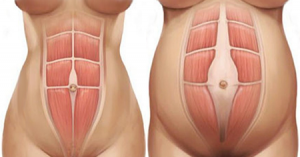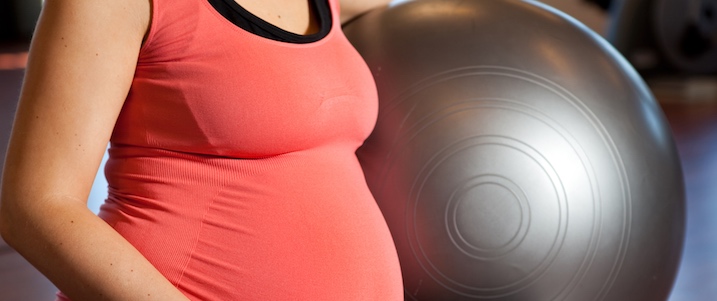Ask any Mum and she’ll tell you that the bigger the baby grows the harder even the simplest tasks become (you try putting your socks on with a basketball strapped to the front of you sometime!). As the baby grows and ther uterus expands there is a widening and thinning of the gap between the two sections of the rectus abdominis muscle (AKA the 6-pack muscles) leading to abdominal separation. This gap is called rectus diastasis. The muscles have not “torn” rather they have simply separated. The split occurs in the mid-line collagen structures of connective tissue at the front of the abdomen.
An easy way to check if you have a rectus diastasis is if you have a ‘pooching’ or ‘doming’ of your stomach, especially when coming up from a lying position on your back. Women often describe looking several months pregnant, many months after the birth of their child.
Whilst rectus diastasis most commonly occurs during pregnancy, women are not the only ones to suffer it. Newborn babies can also have a diastasis. Men can also experience a diastasis as a result of yo-yo dieting, an incorrect technique of doing sit-ups or weightlifting. This is most commonly linked to poor internal abdominal pressure control and biomechanics. It means you can be fit, and still have a diastasis.
Is it common?
Yes! 2 out of 3 women will experience some degree of rectus diastasis in the first two trimesters of pregnancy and 100% of women have a diastasis during their 3rd trimester. A staggering 66% of women with a diastasis will also have some level of pelvic floor dysfunction and 75% of women will suffer from a pelvic organ prolapse. Although common, this is not normal and can be improved with correct exercise.

Signs to look out for:
• Looking pregnant even though back to pre-pregnancy weight
• Pooching or doming of your stomach
• Weak core and pelvic floor
• Lack of strength and stability in the entire pelvic region and midsection
Why is this so important to fix?
Healing the connective tissue and reducing your abdominal separation or diastasis is important as these muscles are what protects our internal organs and back. Other areas where you can be at increased risk of if not fixed include:
• Lower back pain
• Constipation
• Breathing difficulties
• Hernias
• Pelvic organ prolapse
What should I avoid and what should I do to heal or prevent rectus diastasis?
Exercises to avoid include those that place a huge load on your back and excessive forces through your pelvic floor like:
- running,
- jumping,
- sit-ups,
- deep lunges and
- some pilates movements.
- Holding your breath when lifting heavy objects (including your toddler) should be avoided also.
The majority of cases can be greatly improved as well as prevented through specific core and breathing exercises, correct lifting technique and posture, as well as wearing a splint or compression garments.
Walking, swimming and stationary cycling are all safe forms of cardiovascular exercise you can partake in with rectus diastasis.
For an assessment of your diastasis and a comprehensive exercise rehabilitation program call 02 4655 5588 or book an appointment now to see one of our Osteopaths.








